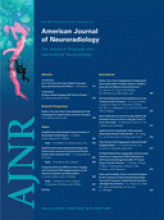Abstract
BACKGROUND AND PURPOSE: Time-resolved (TR) MR angiography (MRA) using parallel imaging techniques is proving to have clinical utility for improving MRA spatial and temporal resolution and separating arterial from venous anatomy. The purpose of this study was to evaluate TR MRA of the intracranial vessels at different integrated parallel acquisition technique (IPAT) factors.
MATERIALS AND METHODS: 3D TR MRA using time-resolved echo-shared angiographic technique was performed with different IPAT factors (0, 2, 3) at 1.5T, resulting in temporal resolutions of 4.0, 1.7, and 1.3 seconds, respectively. We studied 14 subjects, comprising 12 patients with various pathologic conditions and 2 healthy subjects. The brain volume was covered by 36 partitions, and a bolus of 5 mL of gadopentate dimeglumine was administered. Signal-to-noise ratio (SNR), contrast-to-noise ratio (CNR), the number of frames that distinguished between arterial and venous phases, the conspicuity of the vasculature, and artifacts were analyzed.
RESULTS: There was no significant difference in SNR between IPAT factors 0 and 2. Moreover, SNR was significantly lower with IPAT 3 than with IPAT 0 or 2. Smaller vessel segments (M3 and P3) were rated significantly inferior with TR MRA IPAT 2 or 3 compared with MRA without IPAT. For larger proximal vessels (A1 and A2 segments of anterior cerebral artery, M1 and M2 segments of middle cerebral artery, P2 segment of posterior cerebral artery, and basilar artery), there was no difference between TR MRA IPAT 0 and 2.
CONCLUSION: To obtain arterial and venous information in a clinical setting, intracranial TR MRA is best performed with an IPAT factor of 2 with at least 5 mL of contrast.
- Copyright © American Society of Neuroradiology












